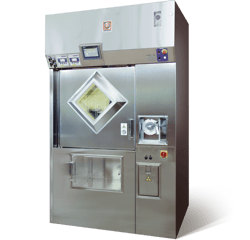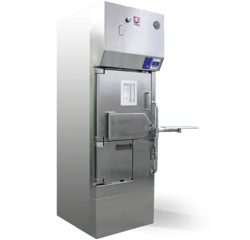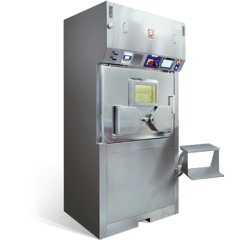Radioiodine handling, how to avoid internal contamination of operators
Comecer's solutions for iodine containment and manipulation
The handling and manipulation of a wide variety of unsealed sources in nuclear medicine centers and radioisotope production centers may cause significant internal exposure for workers.
Iodine and its isotopes are considered one of the most frequently used radionuclides for the diagnosis and radiotherapy of thyroid diseases.
Only one of the thirty-seven known isotopes of iodine, iodine-127, occurs in nature. The others are radioactive. The half-lives of the other iodine radioisotopes are only a few days longer. Some of them are utilized in medicine in relation to the thyroid gland, which is where the body stores and concentrates the iodine that enters. Iodine-123 has a half-life of thirteen hours and decays by electron capture to tellurium-123, emitting gamma radiation; it is used in nuclear medicine imaging, including single photon emission computed tomography (SPECT) and X-ray computed tomography (X-Ray CT) scans.
Iodine-125 has a half-life of fifty-nine days, decaying by electron capture to tellurium-125 and emitting low-energy gamma radiation; the second-longest-lived iodine radioisotope, it has used in biological assays, nuclear medicine imaging, and in radiation therapy as brachytherapy to treat a number of conditions, including prostate cancer, uveal melanomas, and brain tumors.
Finally, iodine-131, with a half-life of eight days, beta decays to an excited state of stable xenon-131 that then converts to the ground state by emitting gamma radiation. It may be absorbed through contaminated food, and will also accumulate in the thyroid. As it decays, it may cause damage to the thyroid. The primary risk from exposure to high levels of iodine-131 is the chance occurrence of radiogenic thyroid cancer in later life. Other risks include the possibility of non-cancerous growth and thyroiditis. However, iodine-131 may also be used for medicinal purposes in radiation therapy for this very reason, when tissue destruction is desired after iodine uptake by the tissue.
Iodine-131 is also used as a radioactive tracer.
Due to the chemical and physical properties of the Iodine, internal contamination of workers (radiopharmacists, radiochemists, nuclear technologists, etc) by radioiodine may occur principally through inhalation of airborne iodine as an aerosol and iodine vapor, especially when it is handled in a not proper environment. Even if the workers are using shielded hot cells/isolators, to protect themselves from the radiation, still the chemical and physical properties of the Iodine have to be taken into account, even if just small quantities are manipulated. For this reason, it is necessary to work always in sealed and closed environments.
For iodine manipulation, when the isotope is not labelled, the iodine is extremely volatile. A hot cell in turbulent airflow is needed (for non aseptic applications) and in this case the hot cell ventilation must be equipped with filtration stages dedicated to trap iodine.
For this option, Comecer already has two solutions: MIP Series, the Shielded Cell for Synthesis Modules and Research Activities, and MiniMa, the Manual R&D hot cell.
When aseptic manipulation is required, so LAF ventilation, recirculation is not allowed, so complete exhaust LAF must be configured in the hot cell.
When instead the iodine isotopes are labelled (radiopharmaceutical handling), in most cases they're not volatile anymore, so standard configuration of filtration and LAF can be used in the hot cells/isolators
In this last case Comecer can provide different solutions already available on the market like:
Otherwise, in case of not labelled Iodine, still we can offer customized solutions.
Would you like to know more?
Contact us



